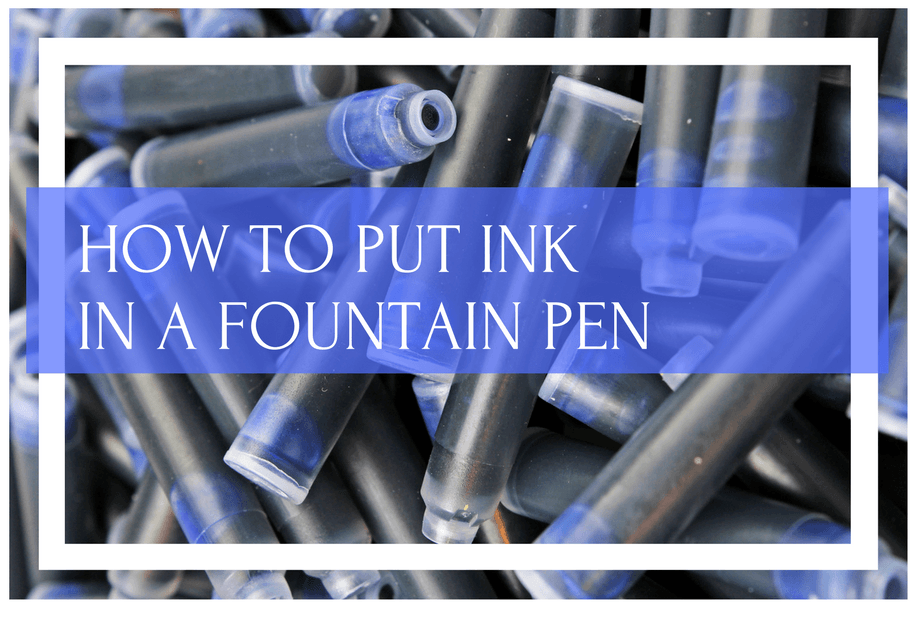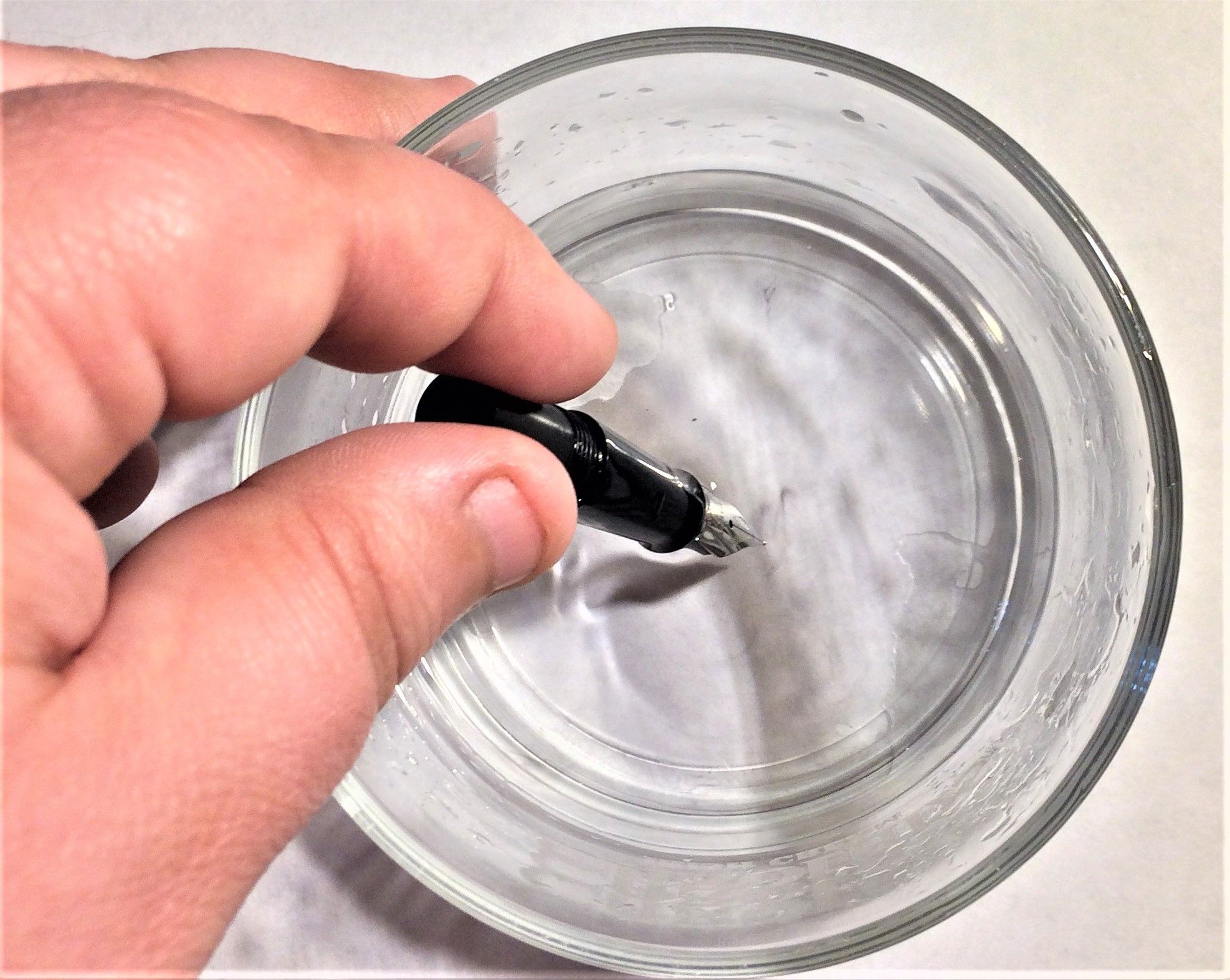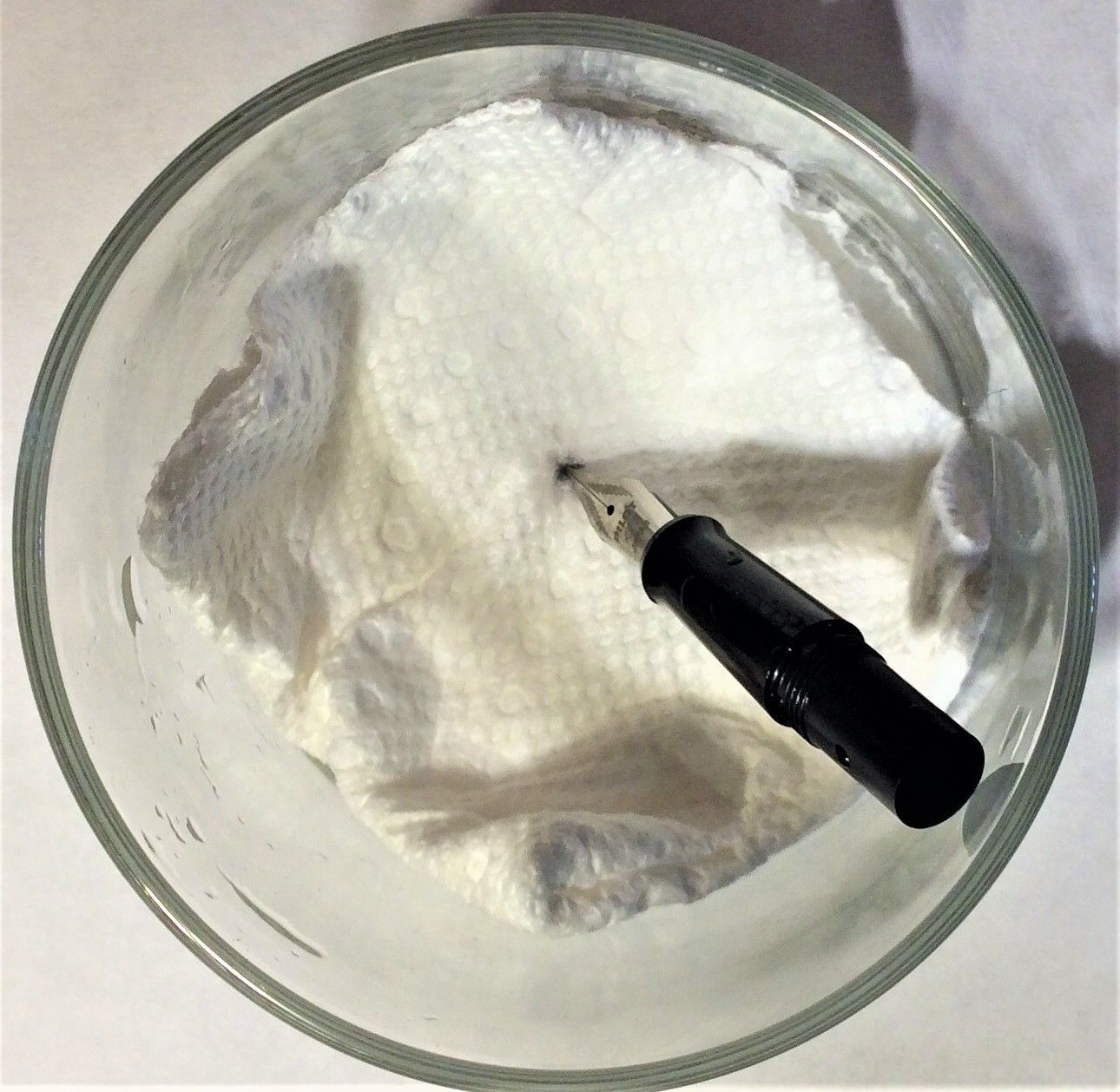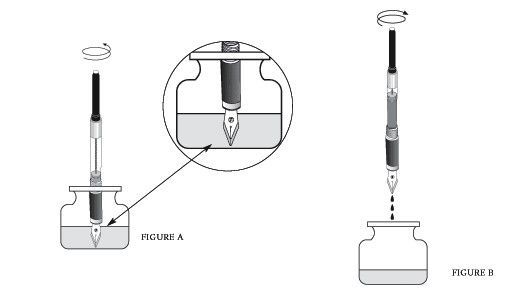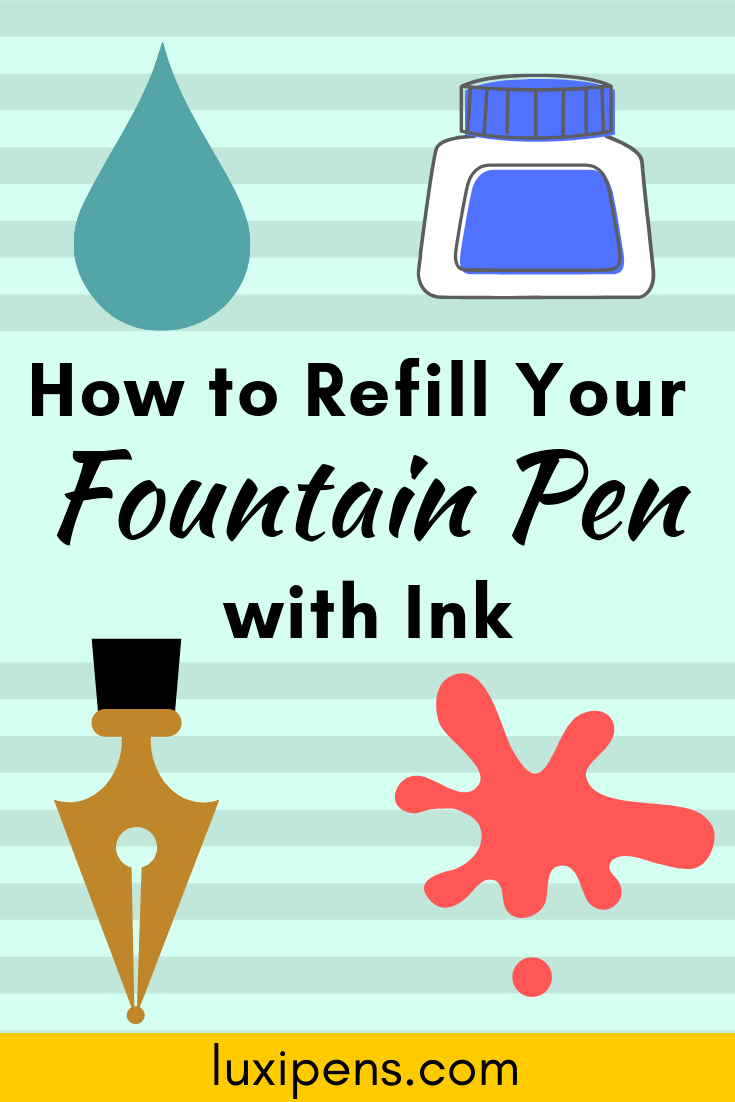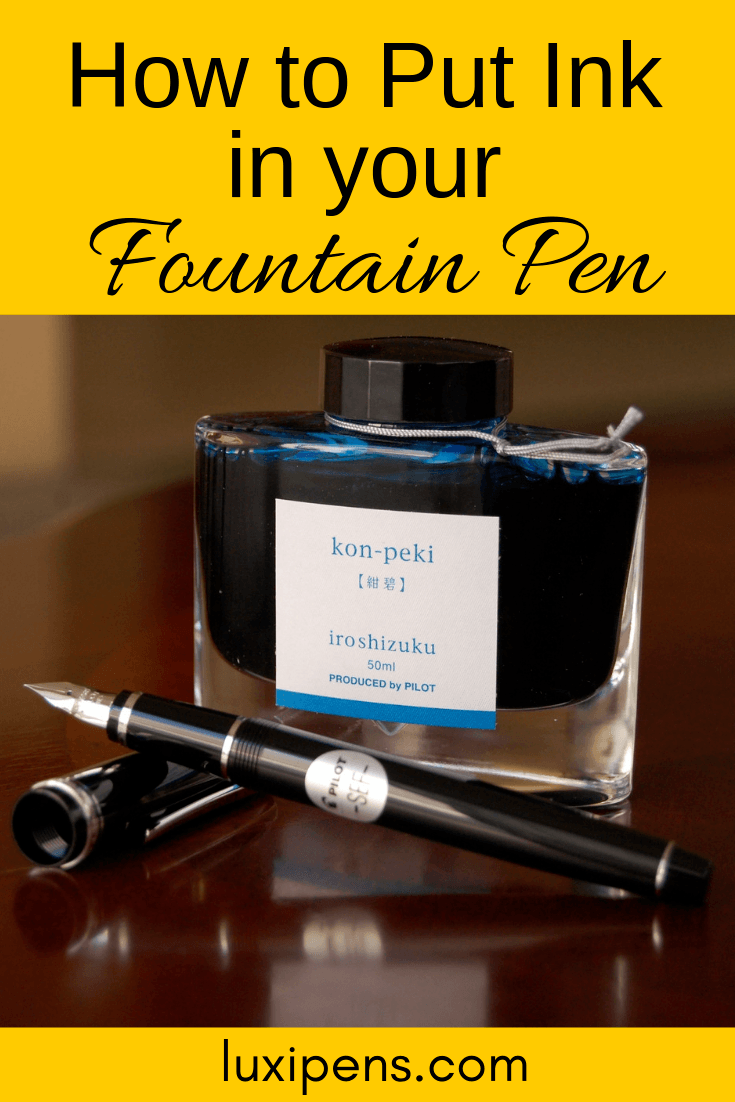Wondering how to put ink in a fountain pen?
Refilling the ink is one of the most routine forms of fountain pen maintenance you will perform.
There are two (2) main types of refilling systems:
- A cartridge refilling system, which uses a fountain pen ink cartridge.
- A bottled ink system, which uses a bottle of ink to refill your pen.
A cartridge refilling system requires disposable ink cartridges that are removed and replaced when the ink runs out.
Converter, ink bladder, barrel, and built-in refilling systems all use bottled ink for refilling.
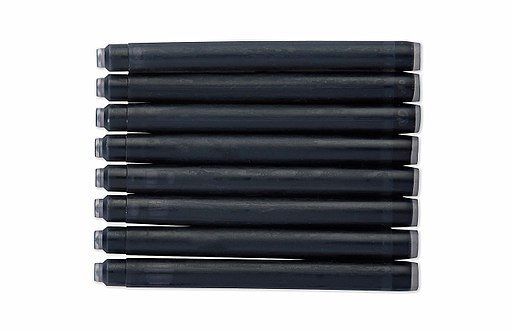
Waterman ink cartridges, courtesy of Francis Flinch

A green ink bottle, courtesy of Poulpy
A Note on Fountain Pen Maintenance:
Warranty Warning:
Separating all of the parts can result in damage that voids a manufacturer’s warranty. For example, Montblanc offers a two-year warranty against manufacturing defects and an international warranty for purchases outside of the United States. However, they do not cover damage from dismantling your pen outside of the instructions provided in the user’s manual. Pilot/Namiki also offers the same protection against defective parts or assembly, but it does not include “unreasonable misuse” by handling the pen in a fashion not outlined in the user manual.
Parts of a Fountain Pen
Part | Function |
|---|---|
Cap | A lid that attaches to the barrel and covers the nib |
Nib | The metal tip that distributes ink to paper |
Grip | Section connected to the nib and held in hand during writing |
Barrel | The outer chamber that covers or contains the ink reservoir; in some fountain pen models, the entire barrel is the ink reservoir |
Ink Reservoir | The container inside of a fountain pen that holds ink; come in many forms; some are built-in to the design of the pen |
Cartridge | A disposable ink reservoir that attaches to the nib and grip; can be replaced or refilled with bottled ink using a syringe |
Ink Bladder (or Ink sac) | A refillable ink reservoir; a plastic sac located inside the barrel attaches to the nib and grip; compressing and releasing on the bladder creates low pressure to pull bottled ink into the bladder |
Ink Converter | A refillable ink reservoir located inside the barrel that attaches to the nib and grip; has a mechanism that uses low pressure to pull ink from a bottle into the reservoir |
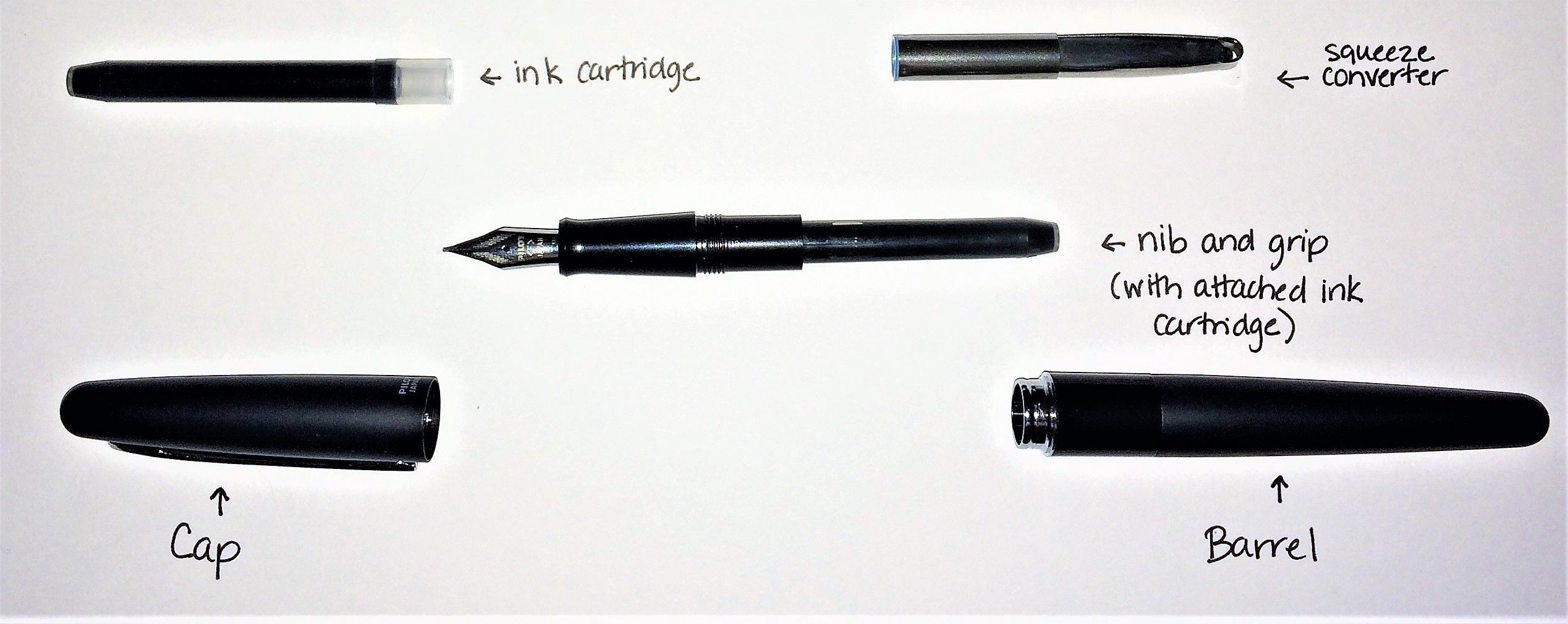
Interested in reading more about why these quality writing instruments are called fountain pens? Be sure to check out our article "Why is a Fountain Pen Called a Fountain Pen?".
Fountain Pen Maintenance
Regularly cleaning your fountain pen is important for optimal performance and will make refilling the ink a smoother process. If you use the pen often, you should routinely clean it about once a month.
Fountain Pen Troubleshooting
Cleaning solves these common fountain pen problems:
How to Clean a Fountain Pen
How to take apart a fountain pen
The standard disassembly process is to:
- 1Remove the cap.
- 2Unscrew the nib and grip from the fountain pen by turning it counterclockwise.
- 3Remove the barrel to expose the ink reservoir.
Any further disassembly could break parts of the pen or violate your warranty. Your disassembled pen should only be in three (3) pieces: the cap, the nib and grip (attached to the ink reservoir), and the barrel. The only exception to this rule is if your fountain pen has a barrel refilling system, in which case there is no ink reservoir attached to the nib and grip.
In some fountain pen models, the nib detaches from the grip, but this is unnecessary for a thorough cleaning. Separating the nib and grip could damage either part, and your warranty may not cover the repairs.
Cleaning your fountain pen
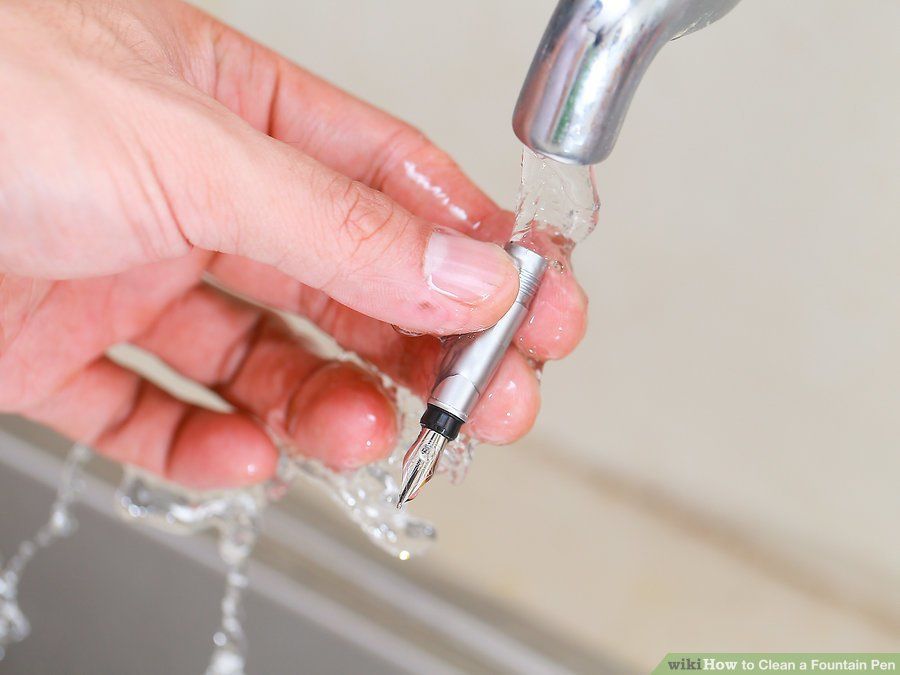
Cleaning the nib Source: Wikihow
To clean your fountain pen:
- 1Remove the cartridge or converter from the nib and grip.
- 2Gently pull on the cartridge or converter until it detaches. Using excessive force to remove the cartridge or converter risks damage to the pen.
- 3Seal the opening of your cartridge or converter using pressure-sensitive tape to save the ink from drying out while cleaning your pen.
Pressure sensitive tape is a tape which uses pressure to activate the adhesive. Scotch tape is a famous pressure-sensitive tape that is readily available.
- 4Run the nib and grip under cold or room-temperature water to remove dried ink and particles. Using warm or hot water can damage the nib.
- 5After rinsing, soak the nib in a cup of clean water, replacing the water supply when it turns colors from residual ink draining from the nib and grip.
- 6Repeat until the water remains clear for over an hour.
- 7Place a paper towel at the bottom of a clean, dry cup. Place the nib inside the cup pointing downwards for about twenty-four hours. The water will drain out of the nib and grip to dry it properly.
Reassemble your pen
After the nib and grip completely dries, remove the pressure-sensitive tape from the opening of the cartridge or converter before reattaching it to the nib and grip. If you are replacing your ink, install a new ink cartridge or fill your converter with bottled ink. Replace the barrel and turn the nib section clockwise to close the pen.
Fountain Pen Flushing
“Flushing” is a cleaning process used when your fountain pen has a built-in ink refilling system or converter. Just as with cleaning, always flush your fountain pen when changing inks or you notice that your pen is not writing properly.
To flush your fountain pen:
- 1Remove the nib from the barrel and the refilling system.
- 2Run nib under cold or room-temperature water.
- 3Place refilling system open-end down in a clean cup of water.
- 4Clean the refilling system chamber by filling it with water and emptying it.
- 5Reassemble nib to the refilling system.
- 6Use refilling system to move water in and out of the nib; replace water as needed; repeat until clear water comes out of the nib.
- 7Soak nib in water for at least an hour to remove remaining ink.
- 8Dry nib and reassemble pen.
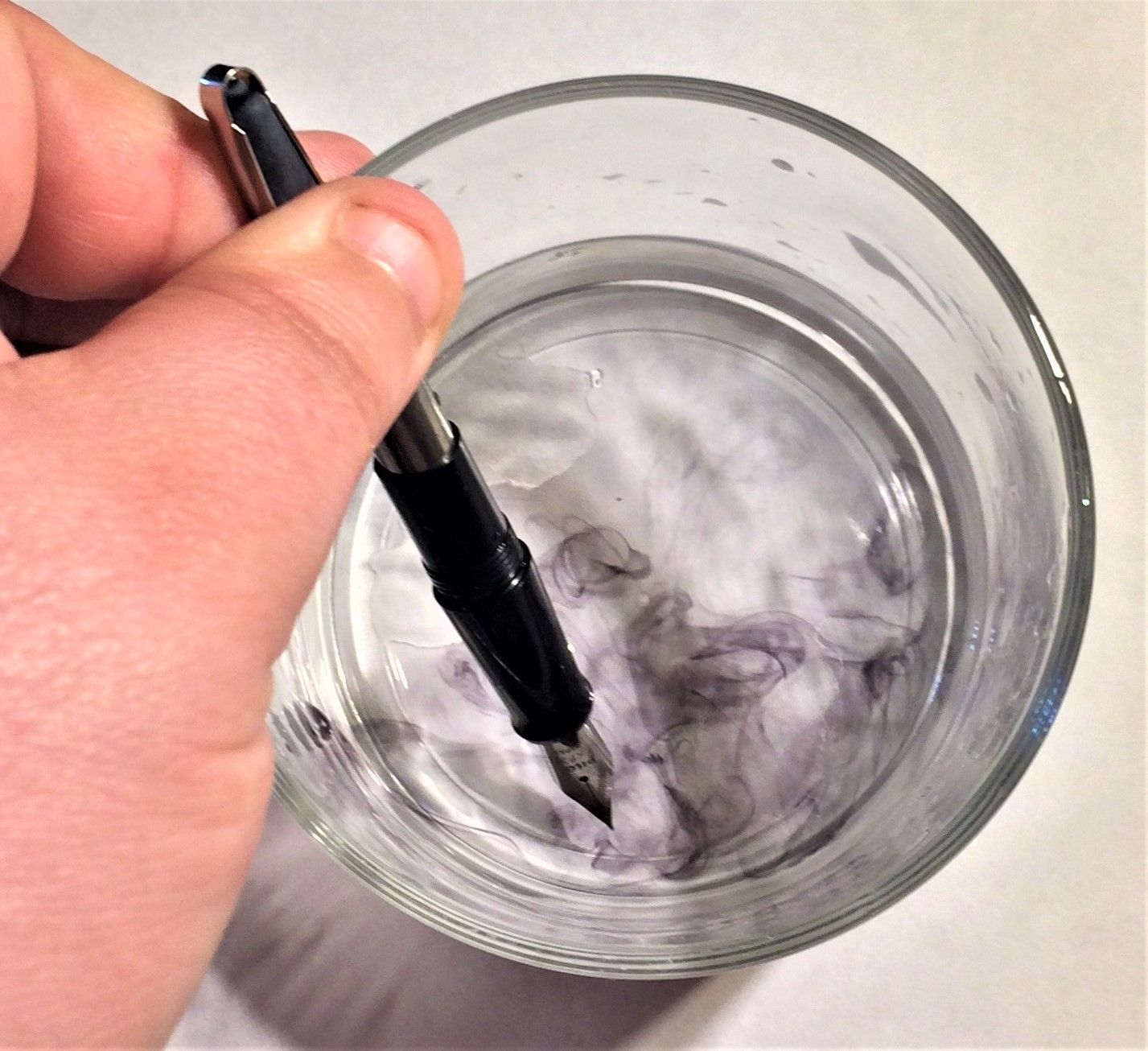
Squeeze water in and out of converter, courtesy of author
Fountain Pen Filling Systems
Understanding filling systems and how they work will help you maintain your fountain pen so that it will last for years. The type of filling system you have will affect how you refill your fountain pen and can influence which types and brands of fountain pens you will purchase. To find out what kind of filling system you have, remove the cap and barrel from your fountain pen. The reservoir attached to the nib and grip show the type of filling system.
There are two main types of reservoirs that use cartridges or bottled ink. Cartridges are disposable units pre-filled with ink. Converters, ink bladders, barrels, and built-in filling systems use a pressure mechanism or a syringe to refill with bottled ink.
How to Fill a Fountain Pen
Filling your fountain pen with ink depends on the type of filling system. “Charging” a fountain pen is another term for refilling your fountain pen with ink.
How to put an ink cartridge in a fountain pen
A fountain pen ink cartridge has a rim that looks like a cup. This inverted rim is the side that connects to the nib and grip. You may see a metal ball inside the cartridge, which moves when changing the cartridge and breaking the opening seal. This metal ball improves the flow of ink by making sure ink does not stick to the sides of the cartridge.
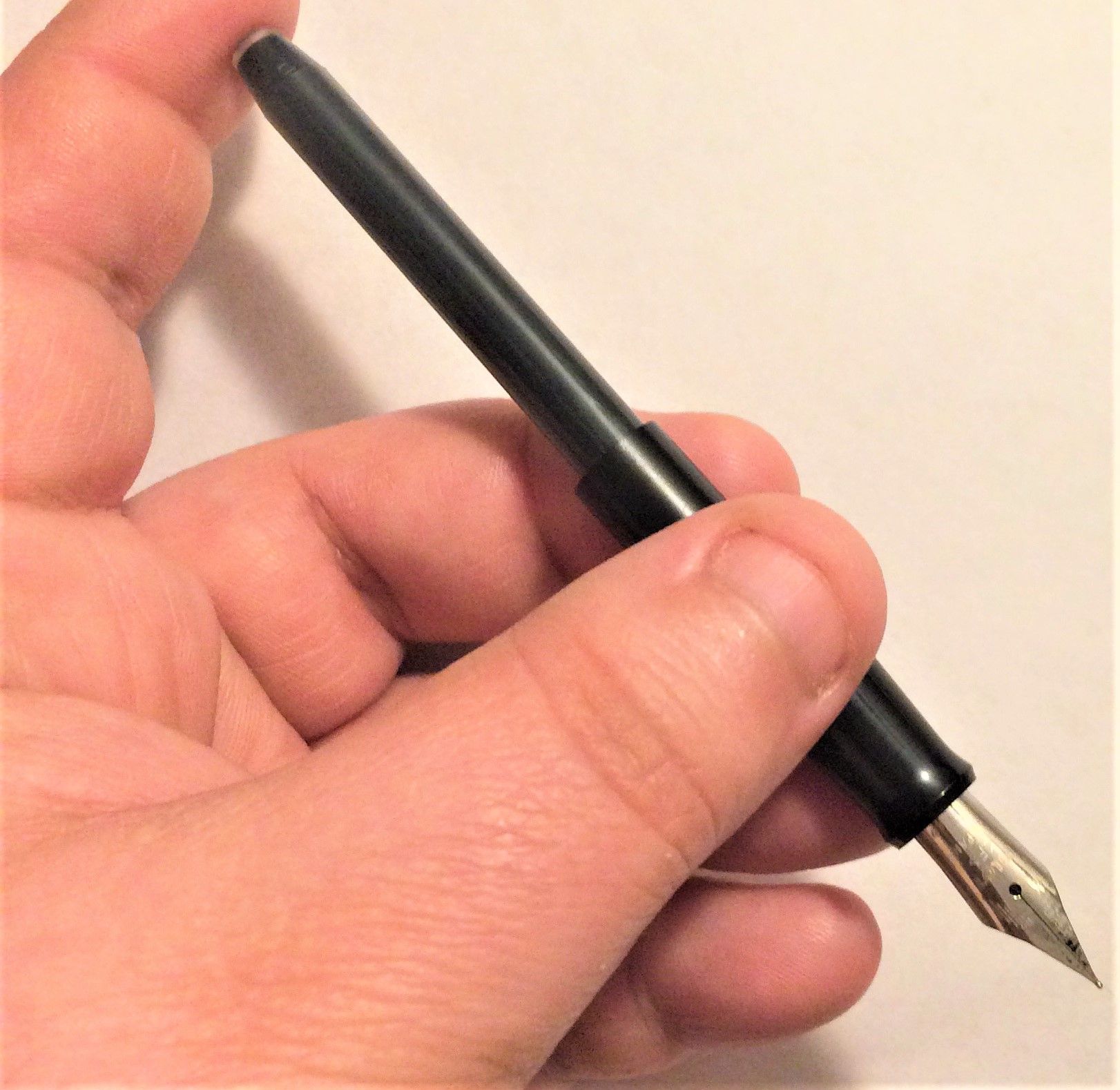
Replacing an ink cartridge in a Pilot Metropolitan fountain pen, photo courtesy of author
Before inserting your ink cartridge, check the barrel of your pen for spacers. Some fountain pen models come pre-loaded with an ink cartridge, with a spacer inside the barrel that fits between the cartridge and the barrel to keep the cartridge in place. Remove this spacer before replacing your empty cartridge by shaking the empty barrel to remove it. Your new ink cartridge can get stuck inside of the barrel without removing the spacer.
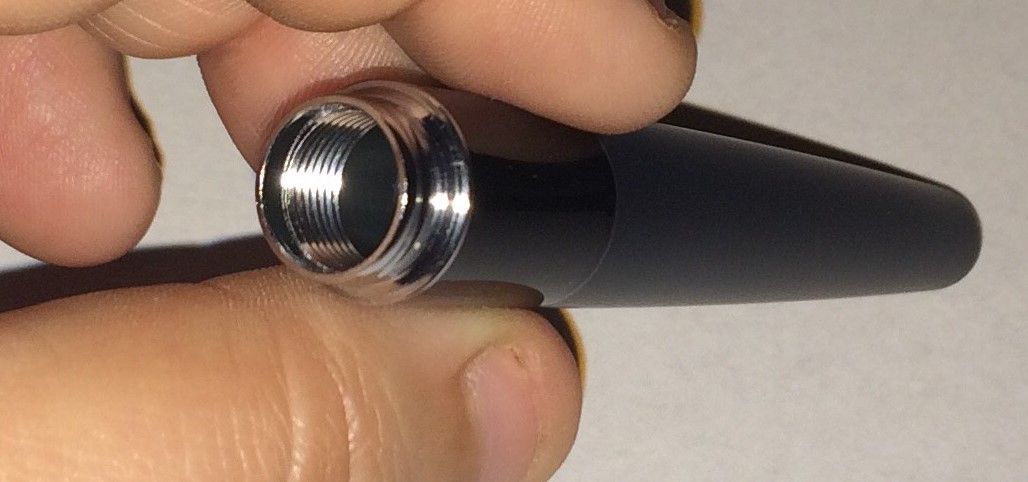
Check the Barrel for Spacers, courtesy of author
To insert an ink cartridge:
- 1Remove the barrel from nib and grip.
- 2If you are replacing an empty ink cartridge, remove empty cartridge by pulling it away from the nib and grip.
- 3Press down until the ink feed punctures the cartridge. This may take some force, but you will hear the sound of a “click,” indicating that the cartridge is properly in place.
- 4Hold pen nib down to allow ink to flow to the nib; may take an hour or two.
- 5To improve the flow of ink, cover the nib and gently shake the pen to move the ink down to the nib faster. Dipping the tip of the nib in clean water also promotes ink flow.
Fountain pen ink cartridge sizes
See your pen manufacturer’s website or consult the instructions that come with your fountain pen for information on what type of ink cartridge to use for your pen. Fountain pen ink cartridges come in three sizes:
- 1Standard international long
- 2Standard international short
- 3Proprietary cartridges – ink cartridges that are made specifically for your pen
How to refill a fountain pen ink cartridge
Although ink cartridges are disposable, they can be refilled with bottled ink to save money and reduce waste.
To refill an ink cartridge with bottled ink:
- 1Remove the empty cartridge from the nib and grip.
- 2Clean any residue from the rim and inside of the cartridge with a cotton swab.
- 3Use an eyedropper or a syringe to refill empty cartridge with bottled ink.
- 4Reattach the cartridge to the nib of the fountain pen.
Fountain pen ink cartridges: Pros and Cons
Pros
Cons
Fountain pen converters
A converter filling system is an ink reservoir, similar to a cartridge, which attaches to the nib and grip. The converter uses a plunger or another mechanism to produce low pressure to pull ink from a bottle into the reservoir.
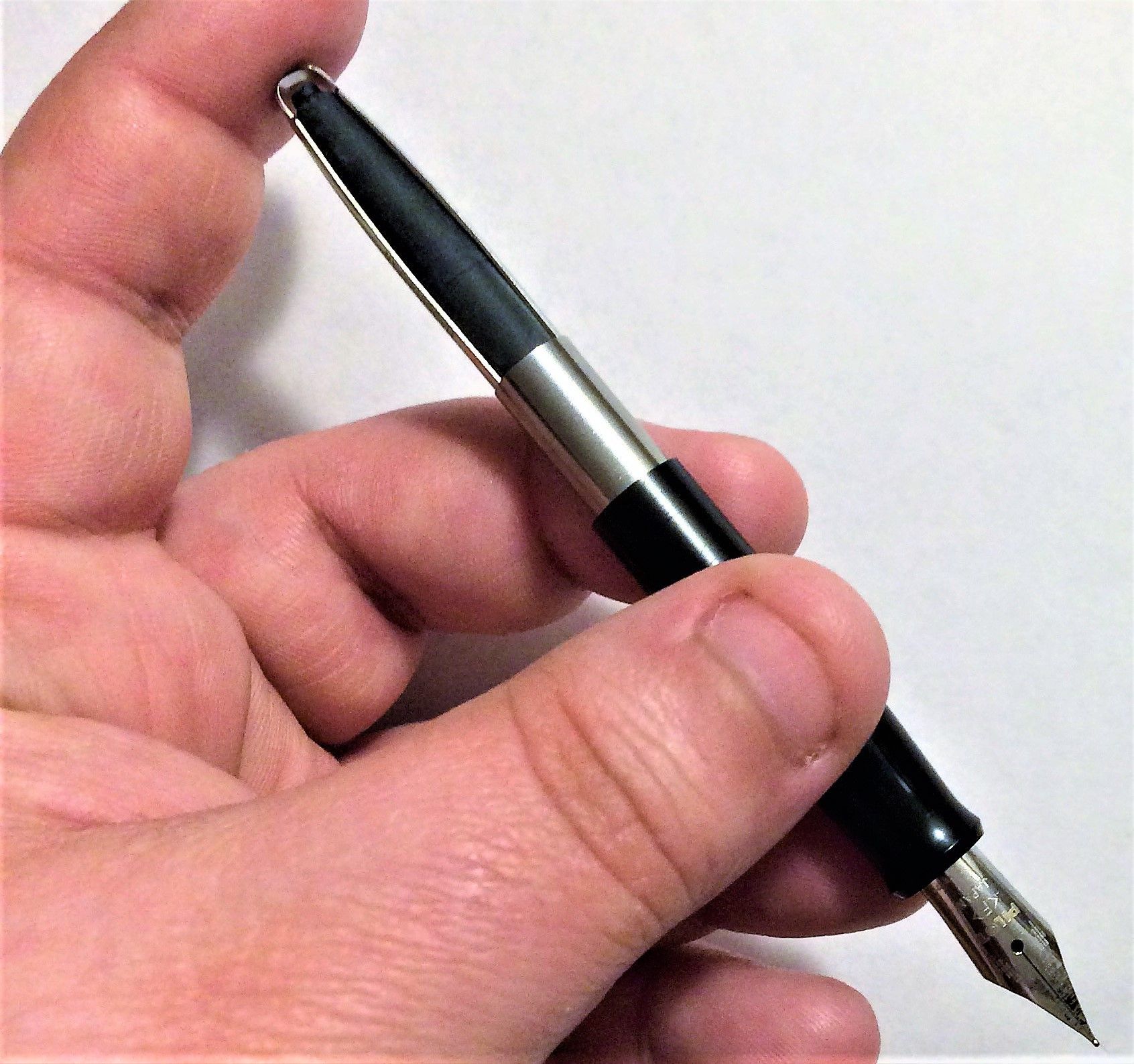
Inserting a Converter, courtesy of author
There are two types of converters: a piston converter and a squeeze converter. A piston converter twists to release air and fill the reservoir with ink. Applied pressure to a squeeze converter releases air to fill the converter with ink.
How to fill a piston converter:
- 1Completely submerge nib in ink bottle.
- 2Turn top of piston converter counterclockwise to release air.
- 3Turn top of piston converter clockwise to suck ink inside the converter.
- 4Hold pen above the ink; gently turn piston converter counterclockwise until you see a drop of ink come to the nib.
- 5Use blotter paper or lint-free cloth to clean the nib of ink.
How to fill a squeeze converter:
- 1Completely submerge nib in ink bottle.
- 2Squeeze converter to force air out of the empty chamber. You will see bubbles in ink bottle.
- 3Release pressure on the converter slowly. Low air pressure will fill the converter with ink.
- 4Keep squeezing and releasing until there are no air bubbles in ink bottle.
- 5Use blotter paper or lint-free cloth to clean the nib of ink.
Fountain pen converters: Pros and Cons
Pros
Cons
Fountain pen ink sac (bladder)
An ink sac, also called an ink bladder, is a plastic sac attached to the nib located inside the barrel. Applying pressure empties air from the sac to fill it with ink.
How to fill a fountain pen bladder:
- 1Dip nib in ink bottle and squeeze until all the air comes out of the sac.
- 2Release pressure until the sac fills with ink.
- 3Repeat until you fill the bladder completely with ink.
- 4If there are bubbles inside the sac, the ink bladder may not be securely in place. Remove the bladder and firmly reattach it to the nib of your pen.
- 5Remove the nib from the bottle and clean with a paper towel or blotter paper.
Some ink barrel fountain pens have metal mechanisms to assist with refilling the ink bladder that look like a flat metal bar, a crescent-shaped metal bar, or a lever. Vintage pens commonly have lever mechanisms, and they are rarer than the metal bar or crescent ink bladder mechanisms. Applying pressure to these mechanisms empties the ink bladder of air and sucks ink into the bladder to fill it.
How to fill with the metal bar mechanism:
- 1Completely submerge nib in ink.
- 2Apply pressure to metal bar on the side of the barrel to empty air from the bladder.
- 3Release the bar to fill the bladder with ink.
- 4Pull nib out of ink bottle and wipe away excess ink with blotter paper or lint-free cloth.
How to fill with the crescent-shaped mechanism:
- 1Rotate locking ring to open.
- 2Submerge nib in a bottle of ink.
- 3Apply pressure to crescent on the side of the barrel to empty air from ink bladder.
- 4Pull nib out of ink bottle and wipe away excess ink with blotter paper or lint-free cloth.
- 5Turn locking ring to secure pen and hold crescent in place.
- 6Wipe away excess ink with blotter paper or lint-free cloth.
How to fill with a lever:
- 1Lift lever to empty air out of the ink bladder.
- 2Submerge nib in an ink bottle.
- 3Release lever. Air pressure will fill the ink bladder.
- 4Repeat lifting and releasing lever until ink bladder is full.
- 5If there are air bubbles inside of the bladder, you need to repeat the process of lifting and releasing the lever until there are no more air bubbles inside the ink bladder.
Fountain pen ink sac: Pros and Cons
Pros
Cons
Fountain pen barrel
A fountain pen with a barrel refilling system is a pen whose entire barrel is filled with ink via an eyedropper or a syringe. These pens are often called “eyedropper pens.” The oldest fountain pen models had barrel refilling systems.
How to refill ink barrel:
- 1Unscrew barrel from the nib and grip.
- 2Place O-ring at the bottom of the threads to create a seal when closing the pen.
- 3An alternate sealing method is sealing threads with silicone grease, which will prevent leakage.
- 4Use an eyedropper or a syringe to fill the barrel with ink to the threads.
Fountain pen barrel: Pros and Cons
Pros
Cons
Built-in filling system
Fountain pens with built-in filling systems already have an ink reservoir attached to the nib. These permanent reservoirs are more convenient because they hold more ink than a cartridge or a converter. There are two types of built-in filling systems which use different mechanisms.
The built-in piston system is similar to the piston converter, except the piston is already attached to the nib and grip. The built-in vacuum system uses a plunger to refill the ink in an up-and-down motion, and there is no twisting involved. Always flush the piston or vacuum systems before refilling or changing inks.
How to use a built-in piston refilling system:
- 1Twist the piston until it extends fully and empties the air out of the reservoir.
- 2Cover nib in ink bottle.
- 3Twist slowly in the opposite direction to fill the reservoir with ink. Twisting slowly will prevent air bubbles.
- 4Remove nib from ink and let a few drops of ink fall from the nib.
- 5Turn your fountain pen upside down (nib facing up) to release any air from the filling system.
- 6Close the pen and wipe excess ink off of the nib.
How to use a built-in vacuum filling system:
- 1Remove knob at the tip of the pen (opposite of the nib).
- 2Push plunger down to remove air and excess ink.
- 3Cover nib in ink bottle.
- 4Pull the plunger until it is fully extended, drawing ink into the reservoir. Pull the plunger slowly to prevent air bubbles inside the reservoir.
- 5Repeat until the reservoir is full or if air bubbles appear in the reservoir.
- 6Remove nib from ink and wipe away excess with paper towel or blotter paper.
Built-in Filling Systems: Pros and Cons
Pros
Cons
Pros and Cons of Filling Systems: A Comparison
Filling Mechanism | Pros | Cons |
|---|---|---|
Cartridge | ||
Converters | ||
Ink Bladder | ||
Barrel | ||
Built-in |
Fountain pen filling systems: What is the best refilling system in fountain pens?
When searching for the perfect fountain pen, the refilling technique often plays a factor in which pen you will choose. Cartridge and ink bladder fountain pens are the most straightforward mechanisms, and their simplicity makes them highly desirable. Having either a cartridge or a converter system is more convenient if you are looking for a quick refilling process. Either a converter, barrel, or built-in system allows more ink variety; with thorough cleaning and flushing, you can experiment with different colors and brands of ink.
If the price is a factor in choosing a fountain pen, cartridge fountain pens are the cheapest on the market, and the overall cost decreases on cartridge replacements if you refill the cartridges at home with bottled ink and a syringe. Fountain pens with barrel and built-in filling systems are more expensive, but they do not require replacement cartridges.
If you are looking for a low-maintenance fountain pen, cartridge and converter filling systems need little maintenance compared to barrel and built-in filling systems. Cartridge fountain pens also travel well, for they do not require anything other than a replacement cartridge when the ink runs out.
As a recent fountain pen convert, I have found that the cartridge refilling system works the best for me. I write all day long, so the ease of snapping out an empty cartridge and replacing it with a new one appeals to me. My very first fountain pen, the Pilot Metropolitan, came with both a cartridge and a squeeze converter filling system so that I can alternate between ink reservoirs. The filling system I use depends on my activity. I use the converter when writing at home and I use the cartridges when traveling. The cartridges are simple to replace on-the-go and they are small enough to fit in my carry-on bag.
Sources
Please comment and share below
Although this article is comprehensive, the information presented is only as accurate the material we were able to source, and is by no means exhaustive, authoritative, nor complete. If you have additions or corrections which you believe should be included in this page, we invite you to include your comments below. Please consider sharing both the citation as well as the new information with us. Our goal is to foster an open dialogue with our readers.
Please also share the article with fountain pen or ballpoint pen enthusiasts. We appreciate you spreading the word!

